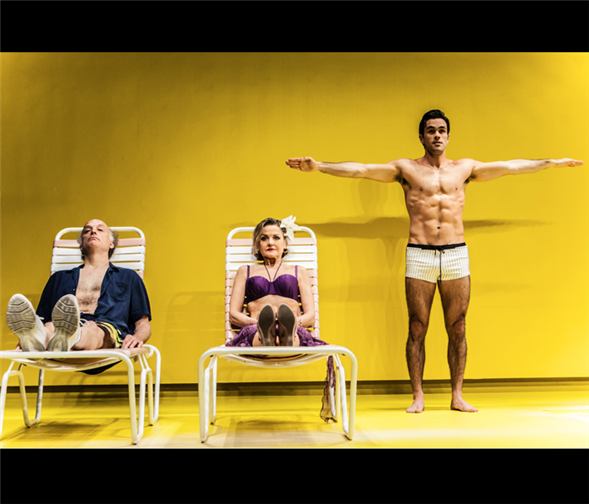Translate Page

Albee, Kennedy, and Fornés share a single stage
---
Signature Theatre is a great place to have a conversation. Open to the public, the spacious central lobby of the Pershing Square Signature Center offers plenty of places to chat and ample opportunities to run into friends and former colleagues—and that's by design. Founding Artistic Director Jim Houghton often spoke about the lobby as a place for "orchestrated collisions," and in Signature's lexicon, that phrase describes how people, plays, and ideas interact by virtue of their sheer proximity.
As director Lila Neugebauer says, "The art reverberates across the architecture of the building."
With that in mind, Signature and Neugebauer are orchestrating a collision of their own. In Signature Plays, running through June 12, three audacious short works are being mounted in a single production. The Signature produced all three pieces – Edward Albee's The Sandbox, Maria Irene Fornés' Drowning, and Adrienne Kennedy's Funnyhouse of a Negro -- during its first decade, and now in its 25th anniversary season, it's reminding us how much they still have to say.
"Each writer's theatrical imagination is singular," says Neugebauer, who helms the entire production. So instead of tying the plays together through a shared style or design, she's letting each piece reflect the playwright's idiosyncratic voice. That gives the title Signature Plays a double meaning: the event represents not only the theatre company, but also something essential about the authors.
Take The Sandbox, which was written in 1959 and features the acerbic humor and ominous undertones of Albee's more well-known works. The play begins innocently enough—a young man is doing calisthenics on a bright beach when Mommy and Daddy arrive with Grandma and a cellist in tow—but ventures into unexpected territory as night falls and the young man reveals his identity.
Meanwhile, Drowning, which is based on a Chekhov short story of the same name, reflects Fornés's preoccupation with how language works. Written in 1985, the play takes place in several short scenes, each a conversation between three men, one of whom falls in love with a woman whose picture he discovers in a newspaper. That may sound straightforward, but the playwright's trademark theatricality is immediately obvious in the costumes: The actors become gelatinous figures, wearing rotund bodysuits and lumpy, grotesque masks that cover their heads.
Then there's the surrealist nightmare of Funnyhouse of a Negro, which encapsulates the power of Kennedy's technique. The central figure, Sarah, is a writer who has a white mother and a black father, whom she claims to have murdered with an ebony mask. Characters such as Jesus, Queen Victoria, and Patrice Lumumba haunt Sarah's room like specters, giving life to her divided and tortured identity.
In letting all three works stand on their own, Neugebauer has nevertheless found common themes. "All of these plays deeply engage the body," she says. "Its decay, its beauty, the inescapable torment of being bound to a sack of flesh." She adds that the trio also deals with "innocence and experience, and the cost of experience."
Neugebauer says she especially admires "the astonishing bravery with which these writers address the complete scope of the human experience in all of its extraordinary resilience, horrible devastation, and torment. It's so raw and brave. It's an invitation and a reminder to writers to put your guts out there."
---
Follow David Bruin at @DavidBruin216. Follow TDF at @TDFNYC.
Photos by Monique Carboni. Top phto (L to R): Frank Wood, Alison Fraser, and Ryan-James Hatanaka in The Sandbox
TDF Members: Go here to browse our discounts for theatre, dance, and concerts.